Quantification of Biodiversity Loss in Building Life Cycle Assessment: Insights Towards Regenerative Design
Abstract
1. Introduction
- RQ: How do buildings with different typologies and material compositions perform in relation to their impact on climate change and biodiversity loss?
2. Background
2.1. Building Life Cycle Assessment (LCA)
- The requirements now cover all new buildings, no matter the reference area. The new upper limits are presented in Table 1.
- Two modules are added to the required calculation: transportation to the site (A4) and construction activities (A5), calculated separately with a limit value of 1.5 kg CO2-eq./m2/year [28].
2.1.1. LCI and LCIA Methods
2.1.2. LCA Databases
2.1.3. LCA Tools
| Methods and Databases | Ecochain Helix | SimaPro | LCA for Experts | OneClick LCA | OpenLCA |
|---|---|---|---|---|---|
| CML-IA | ✓ | ✓ | ✓ | ✓ | ✓ |
| TRACI | ✓ | ✓ | ✓ | ✓ | ✓ |
| PEF | ✓ | ✓ | ✓ | ✓ | ✓ |
| ReCiPe 2016 | ✓ | ✓ | ✓ | ✕ | ✓ |
| Impact World+ | ✕ | ✓ | ✕ | ✕ | ✓ |
| LC-impact | ✕ | ✓ | ✕ | ✕ | ✓ |
| Ecoinvent | ✓ | ✓ | ✕ | ✓ | ✓ |
| GaBi (Sphera) | ✕ | ✕ | ✓ | ✕ | ✕ |
| Ökobaudat | ✕ | ✕ | ✕ | ✓ | ✓ |
| EPD Danmark | ✕ | ✕ | ✕ | ✓ | ✕ |
2.2. Biodiversity Loss
- (A)
- The practitioner can buy a licence to a database using endpoint LCIA methods and match these materials with their LCA results. Based on this material match, the tool will calculate biodiversity loss.
- (B)
- A set of correction factors to account for missing impact categories can be multiplied by material amounts in the LCA. The results from selected impact categories are inserted into the Off-Site Biodiversity Tool, which calculates the corresponding biodiversity impact. This second method has higher uncertainty, as no biodiversity impacts are calculated for each individual material but only for the material group.
2.3. LCA of Bio-Based Materials
3. Materials and Methods
3.1. LCA Methodology for Climate Change
- EPD Danmark;
- EPD Norge;
- IBU (Germany);
- EPD International (Sweden).
3.2. LCA Methodology for Biodiversity Loss
- The choices made in methodology in Section 3.1 related to life cycle stages (Table 8), building parts (Table 9), and the reference study period.
- The number of replacements will follow the model presented in Section 3.1.
4. Case Studies
4.1. Presentation of the 73 Case Buildings
4.2. Results from the LCAs of Case Buildings
4.3. Results from the Biodiversity Calculations of Case Buildings
5. Discussion
5.1. Considerations of LCA Methodology
Comparison with the New Danish Regulations
5.2. Comparison of Results for GWP and Biodiversity Loss
5.2.1. Embodied Impact of Case Buildings
5.2.2. Operational Impact of Case Buildings
6. Conclusions
Research Limitations and Future Work
Author Contributions
Funding
Institutional Review Board Statement
Informed Consent Statement
Data Availability Statement
Acknowledgments
Conflicts of Interest
Abbreviations
| BR25 | Danish Building Regulations |
| EPD | Environmental Product Declaration |
| GWP | Global Warming Potential |
| LCA | Life Cycle Assessment |
| LCIA | Life Cycle Impact Assessment |
| LCI | Life Cycle Inventory |
Appendix A
| Methods and Databases | Code | Reference Area [m2] | Year of Commissioning | Type of Load-Bearing Structure | Weight [kg/m2] |
|---|---|---|---|---|---|
| Other buildings | Oth01 | >5000 | 2022 | Heavy | 1545 |
| Oth02 | 1000–5000 | 2023 | Light | 497 | |
| Oth03 | <100 | 2023 | Light | 1692 | |
| Detached houses | D01 | 100–1000 | 2023 | Light | 394 |
| D02 | 100–1000 | 2023 | Light | 391 | |
| D03 | 100–1000 | 2023 | Light | 419 | |
| D04 | 100–1000 | 2023 | Light | 427 | |
| D05 | 100–1000 | 2023 | Light | 430 | |
| D06 | 100–1000 | 2023 | Light | 419 | |
| D07 | 100–1000 | 2023 | Light | 594 | |
| D08 | 100–1000 | 2023 | Light | 849 | |
| D09 | 100–1000 | 2023 | Light | 285 | |
| D10 | 100–1000 | 2022 | Heavy | 1126 | |
| D11 | 100–1000 | 2024 | Light | 655 | |
| Apartments buildings | A01 | >5000 | 2022 | Heavy | 1158 |
| A02 | >5000 | 2023 | Heavy | 1135 | |
| A03 | >5000 | 2023 | Heavy | 1326 | |
| A04 | >5000 | 2024 | Heavy | 1465 | |
| A05 | >5000 | 2023 | Heavy | 1350 | |
| A06 | 1000–5000 | 2023 | Heavy | 1175 | |
| A07 | >5000 | 2025 | Heavy | 1049 | |
| A08 | 1000–5000 | 2026 | Heavy | 1094 | |
| A09 | 1000–5000 | 2026 | Heavy | 1169 | |
| A10 | >5000 | 2026 | Heavy | 1292 | |
| A11 | 100–1000 | 2024 | Heavy | 1168 | |
| A12 | 1000–5000 | 2024 | Heavy | 1208 | |
| A13 | 1000–5000 | 2024 | Heavy | 1155 | |
| A14 | >5000 | 2024 | Heavy | 1574 | |
| A15 | 1000–5000 | 2024 | Heavy | 1521 | |
| A16 | 100–1000 | 2024 | Heavy | 1397 | |
| A17 | >5000 | 2023 | Heavy | 1222 | |
| A18 | >5000 | 2024 | Heavy | 935 | |
| A19 | >5000 | 2022 | Heavy | 1179 | |
| A20 | 1000–5000 | 2024 | Light | 359 | |
| A21 | >5000 | 2025 | Heavy | 1313 | |
| A22 | >5000 | 2025 | Heavy | 1244 | |
| A23 | >5000 | 2024 | Heavy | 1621 | |
| Industry | I01 | >5000 | 2023 | Heavy | 1239 |
| I02 | 1000–5000 | 2025 | Light | 940 | |
| I03 | >5000 | 2023 | Heavy | 826 | |
| I04 | 1000–5000 | 2025 | Heavy | 776 | |
| I05 | >5000 | 2025 | Heavy | 905 | |
| Offices | O01 | >5000 | 2023 | Heavy | 1214 |
| O02 | 1000–5000 | 2023 | Light | 1302 | |
| O03 | >5000 | 2024 | Heavy | 994 | |
| O04 | 1000–5000 | 2026 | Light | 659 | |
| O05 | 1000–5000 | 2025 | Heavy | 970 | |
| Terraced houses | T01 | 100–1000 | 2023 | Light | 742 |
| T02 | 100–1000 | 2023 | Light | 811 | |
| T03 | >5000 | 2022 | Heavy | 957 | |
| T04 | >5000 | 2022 | Heavy | 770 | |
| T05 | 1000–5000 | 2022 | Heavy | 1386 | |
| T06 | >5000 | 2025 | Heavy | 674 | |
| T07 | >5000 | 2022 | Light | 697 | |
| T08 | >5000 | 2022 | Heavy | 1270 | |
| T09 | >5000 | 2024 | Heavy | 724 | |
| T10 | >5000 | 2023 | Light | 370 | |
| T11 | >5000 | 2023 | Light | 548 | |
| T12 | >5000 | 2023 | Light | 419 | |
| T13 | >5000 | 2023 | Heavy | 734 | |
| T14 | 1000–5000 | 2025 | Heavy | 977 | |
| T15 | 1000–5000 | 2025 | Heavy | 835 | |
| T16 | >5000 | 2024 | Heavy | 734 | |
| T17 | 1000–5000 | 2024 | Light | 547 | |
| T18 | 1000–5000 | 2026 | Light | 501 | |
| T19 | 1000–5000 | 2025 | Light | 545 | |
| T20 | >5000 | 2025 | Heavy | 727 | |
| Education | E01 | 1000–5000 | 2025 | Heavy | 1210 |
| E02 | >5000 | 2024 | Heavy | 1426 | |
| E03 | >5000 | 2024 | Heavy | 1237 | |
| E04 | >5000 | 2022 | Heavy | 1381 | |
| E05 | >5000 | 2022 | Heavy | 783 | |
| E06 | 100–1000 | 2025 | Light | 772 |
References
- Steffen, W.; Richardson, K.; Rockström, J.; Cornell, S.E.; Fetzer, I.; Bennett, E.M.; Biggs, R.; Carpenter, S.R.; de Vries, W.; de Wit, C.A.; et al. Planetary boundaries: Guiding human development on a changing planet. Science 2015, 347, 1259855. [Google Scholar] [CrossRef] [PubMed]
- Adams, M.; Burrows, V.; Richardson, S.; Drinkwater, J.; Gamboa, C.; Collin, C.; Den, X.; Riemann, L.; Porteron, S.; Secher, A. Bringing Embodied Carbon Upfront: Coordinated Action for the Building and Construction Sector to Tackle Embodied Carbon; World Green Building Council: Toronto, ON, Canada, 2019. [Google Scholar]
- Paris Agreement to the United Nations Framework Convention on Climate Change. 2015. Available online: https://unfccc.int/process-and-meetings/the-paris-agreement (accessed on 3 February 2025).
- Costanza, R.; d’Arge, R.; de Groot, R.; Farber, S.; Grasso, M.; Hannon, B.; Limburg, K.; Naeem, S.; O’Neill, R.V.; Paruelo, J.; et al. The value of the world’s ecosystem services and natural capital. Nature 1997, 387, 253–260. [Google Scholar] [CrossRef]
- de Groot, R.S.; Wilson, M.A.; Boumans, R.M.J. A typology for the classification, description and valuation of ecosystem functions, goods and services. Ecol. Econ. 2002, 41, 393–408. [Google Scholar] [CrossRef]
- Richardson, K.; Steffen, W.; Lucht, W.; Bendtsen, J.; Cornell, S.E.; Donges, J.F.; Drüke, M.; Fetzer, I.; Bala, G.; von Bloh, W.; et al. Earth beyond six of nine planetary boundaries. Sci. Adv. 2023, 9, eadh2458. [Google Scholar] [CrossRef]
- Costanza, R.; de Groot, R.; Sutton, P.; van der Ploeg, S.; Anderson, S.J.; Kubiszewski, I.; Farber, S.; Turner, R.K. Changes in the global value of ecosystem services. Glob. Environ. Change 2014, 26, 152–158. [Google Scholar] [CrossRef]
- Ceballos, G.; Ehrlich, P.R.; Dirzo, R. Biological annihilation via the ongoing sixth mass extinction signaled by vertebrate population losses and declines. Proc. Natl. Acad. Sci. USA 2017, 114, E6089–E6096. [Google Scholar] [CrossRef]
- Barnosky, A.D.; Matzke, N.; Tomiya, S.; Wogan, G.O.U.; Swartz, B.; Quental, T.B.; Marshall, C.; McGuire, J.L.; Lindsey, E.L.; Maguire, K.C.; et al. Has the Earth’s sixth mass extinction already arrived? Nature 2011, 471, 51–57. [Google Scholar] [CrossRef]
- CBD. Quick Guides to the Aichi Biodiversity Targets; Convention on Biological Diversity: Montreal, QC, Canada, 2013; 42p. [Google Scholar]
- Convention on Biological Diversity. Decision Adopted by the Conference of the Parties to the Convention on Biological Diversity at Its Fifteenth Meeting (COP/15/DEC/4); 2022. Available online: https://www.cbd.int/gbf/targets (accessed on 3 February 2025).
- Andersen, C.E.; Rasmussen, F.N.; Habert, G.; Birgisdóttir, H. Embodied GHG Emissions of Wooden Buildings—Challenges of Biogenic Carbon Accounting in Current LCA Methods. Front. Built Environ. 2021, 7, 729096. [Google Scholar] [CrossRef]
- Mang, P.; Haggard, B.; Regenesis Group. Front Matter. In Regenerative Development; John Wiley & Sons: Hoboken, NJ, USA, 2016; pp. i–xxxvi. [Google Scholar]
- Mang, P.; Haggard, B.; Regenesis Group. Creating Regenerative Projects. In Regenerative Development; John Wiley & Sons: Hoboken, NJ, USA, 2016; pp. 1–8. [Google Scholar]
- Reed, B. Shifting from ‘sustainability’ to regeneration. Build. Res. Inf. 2007, 35, 674–680. [Google Scholar] [CrossRef]
- Sala Benites, H.; Osmond, P.; Prasad, D. A neighbourhood-scale conceptual model towards regenerative circularity for the built environment. Sustain. Dev. 2023, 31, 1748–1767. [Google Scholar] [CrossRef]
- Zari, M.P. Regenerative Urban Design and Ecosystem Biomimicry, 1st ed.; Routledge: London, UK, 2018; p. 260. [Google Scholar]
- du Plessis, C. Towards a regenerative paradigm for the built environment. Build. Res. Inf. 2012, 40, 7–22. [Google Scholar] [CrossRef]
- ISO 18458:2015; Biomimetics—Terminology, Concepts and Methodology. ISO: Geneva, Switzerland, 2015.
- Souza, D.M.; Teixeira, R.F.M.; Ostermann, O.P. Assessing biodiversity loss due to land use with Life Cycle Assessment: Are we there yet? Glob. Change Biol. 2015, 21, 32–47. [Google Scholar] [CrossRef]
- Brachet, A.; Schiopu, N.; Clergeau, P. Biodiversity impact assessment of building’s roofs based on Life Cycle Assessment methods. Build. Environ. 2019, 158, 133–144. [Google Scholar] [CrossRef]
- Bjørn, A.; Fanning, A.; Branny, A.; Clausen, C.; Pham, D.; Engelbrecht, E.; Lassen, E.B.; Sahen, E.; Moberg, F.; Birgisdóttir, H.; et al. Doughnut for Urban Development—A Manual, 2nd ed.; Hill-Hansen, D., Jensen, K.G., Eds.; Danish Architectural Press: Copenhagen, Denmark, 2023; p. 176. [Google Scholar]
- ISO 14040:2006; Environmental Management—Life Cycle Assessment—Principles and Framework. ISO: Geneva, Switzerland, 2006.
- ISO 14044:2006; Environmental Management—Life Cycle Assessment—Requirements and Guidelines. ISO: Geneva, Switzerland, 2006.
- Finnveden, G.; Potting, J. Life Cycle Assessment. In Encyclopedia of Toxicology, 3rd ed.; Wexler, P., Ed.; Academic Press: Oxford, UK, 2014; pp. 74–77. [Google Scholar]
- Simonen, K. Life Cycle Assessment, 1st ed.; Routledge by Taylor and Francis: Milton, UK, 2014; p. 182. [Google Scholar]
- EN 15978:2012; Sustainability of Construction Works—Assessment of Environmental Performance of Buildings—Calculation Method. Dansk Standard: Nordhavn, Denmark, 2012.
- Social-og Boligstyrelsen (Denmark). Ny Aftale Stiller Ambitiøse Klimakrav Til Nyt Byggeri. Available online: https://www.sm.dk/nyheder/nyhedsarkiv/2024/maj/ny-aftale-stiller-ambitioese-klimakrav-til-nyt-byggeri (accessed on 29 April 2025).
- Reduction Roadmap. Beyond the Roadmap: A Transition Plan for the Danish Building Industry, Version 2.14. 2024. Available online: https://www.shareyourgreendesign.com/research/beyond-the-roadmap-a-transition-plan-for-the-danish-building-industry/ (accessed on 20 February 2025).
- Zimmermann, R.K.; Andersen, C.M.E.; Kanafani, K.; Birgisdottir, H. Whole Life Carbon Assessment of 60 Buildings: Possibilities to Develop Benchmark Values for LCA of Buildings; BUILD Report No. 2021:12; Polyteknisk Boghandel og Forlag: Lyngby, Denmark, 2021. [Google Scholar]
- EN 15804:2012; Sustainability of Construction Works—Environmental Product Declarations—Core Rules for the Product Category of Construction Products. Dansk Standard: Nordhavn, Denmark, 2012.
- Ecoinvent. Impact Assessment. Available online: https://support.ecoinvent.org/impact-assessment (accessed on 27 February 2025).
- Institude of Environmental Sciences (CML); Leiden University. CML-IA Characterisation Factors. Available online: https://www.universiteitleiden.nl/en/research/research-output/science/cml-ia-characterisation-factors (accessed on 27 February 2025).
- One Click LCA. Impact Assessment Categories: CML, TRACI, and PEF. Available online: https://oneclicklca.zendesk.com/hc/en-us/articles/360015036980-Impact-Assessment-Categories-CML-TRACI-and-PEF (accessed on 27 February 2025).
- Mattia, D.; Nicola, F.; Ardente, F. Understanding Product Environmental Footprint and Organisation Environmental Footprint Methods; Publications Office of the European Union: Luxembourg, 2022. [Google Scholar]
- Huijbregts, M.A.J.; Steinmann, Z.J.N.; Elshout, P.M.F.; Stam, G.; Verones, F.; Vieira, M.; Zijp, M.; Hollander, A.; van Zelm, R. ReCiPe2016: A harmonised life cycle impact assessment method at midpoint and endpoint level. Int. J. Life Cycle Assess. 2017, 22, 138–147. [Google Scholar] [CrossRef]
- Bulle, C.; Margni, M.; Patouillard, L.; Boulay, A.-M.; Bourgault, G.; De Bruille, V.; Cao, V.; Hauschild, M.; Henderson, A.; Humbert, S.; et al. IMPACT World+: A globally regionalized life cycle impact assessment method. Int. J. Life Cycle Assess. 2019, 24, 1653–1674. [Google Scholar] [CrossRef]
- Verones, F.; Hellweg, S.; Antón, A.; Azevedo, L.B.; Chaudhary, A.; Cosme, N.; Cucurachi, S.; de Baan, L.; Dong, Y.; Fantke, P.; et al. LC-IMPACT: A regionalized life cycle damage assessment method. J. Ind. Ecol. 2020, 24, 1201–1219. [Google Scholar] [CrossRef]
- Damiani, M.; Sinkko, T.; Caldeira, C.; Tosches, D.; Robuchon, M.; Sala, S. Critical review of methods and models for biodiversity impact assessment and their applicability in the LCA context. Environ. Impact Assess. Rev. 2023, 101, 107134. [Google Scholar] [CrossRef]
- ISO 14025:2006; Environmental Labels and Declarations—Type III Environmental Declarations—Principles and Procedures. ISO: Geneva, Switzerland, 2006.
- Pre-Sustainability. Recipe. Available online: https://pre-sustainability.com/articles/recipe/ (accessed on 13 March 2025).
- Zacharia, M. A Simple Guide to EPDs. Available online: https://oneclicklca.com/en/resources/articles/guide-to-epds (accessed on 11 March 2025).
- Su, D.; Ren, Z.; Wu, Y. Guidelines for Selection of Life Cycle Impact Assessment Software Tools. In Sustainable Product Development: Tools, Methods and Examples; Su, D., Ed.; Springer International Publishing: Cham, Switzerland, 2020; pp. 57–70. [Google Scholar]
- European Commission. Nodes Containing EF Data. Available online: https://eplca.jrc.ec.europa.eu/LCDN/contactListEF.html (accessed on 12 March 2025).
- INIES Database. Frequently Asked Questions—INIES. Available online: https://www.inies.fr/en/ressources-documentaires/frequently-asked-questions/ (accessed on 12 March 2025).
- EPD Norge. General Programme Instructions—The Norwegian EPD Program, Version 4.0; EPD Norge: Oslo, Norway, 2024. [Google Scholar]
- Institut Bauen und Unwelt (IBU). Life Cycle Assessment—IBU. Available online: https://ibu-epd.com/en/life-cycle-assessment/ (accessed on 12 March 2025).
- German Federal Ministry for Housing, U.D.a.B.B. Ökobaudat—The German LCA Database for Construction. Available online: https://www.oekobaudat.de/no_cache/en/database/search.html (accessed on 12 March 2025).
- Kamari, A.; Kotula, B.M.; Schultz, C.P.L. A BIM-based LCA tool for sustainable building design during the early design stage. Smart Sustain. Built Environ. 2022, 11, 217–244. [Google Scholar] [CrossRef]
- Kamari, A.; Schultz, C. Streamlining BIM-integrated LCA for rapid-iterative-informed-early stage upfront carbon assessment by architects and engineers. Archit. Struct. Constr. 2024, 5, 5. [Google Scholar] [CrossRef]
- OneClick LCA. About OneClick LCA. Available online: https://oneclicklca.com/company/about-us (accessed on 18 March 2025).
- OpenLCA. About OpenLCA. Available online: https://www.openlca.org/about/ (accessed on 18 March 2025).
- SimaPro. Meet the Developer. Available online: https://simapro.com/meet-the-developer/ (accessed on 18 March 2025).
- Sphera. A Quick Guide to Sphera’s 2023.1 LCA Databases Update. Available online: https://sphera.com/resources/blog/a-quick-guide-to-spheras-2023-1-lca-databases-update/ (accessed on 18 March 2025).
- Ecochain. We Are Ecochain. Available online: https://ecochain.com/about-us/ (accessed on 19 March 2025).
- Sphera. Who We Are. Available online: https://sphera.com/company/who-we-are/ (accessed on 19 March 2025).
- Birgisdottir, H.; Sørensen, C.G.; Rasmussen, F.N. Udvikling af LCAbyg—Livscyklusvurderingsværktøj for den Danske Byggebranche. Available online: https://vbn.aau.dk/en/projects/udvikling-af-lcabyg-livscyklusvurderingsv%C3%A6rkt%C3%B8j-for-den-danske-by (accessed on 24 March 2025).
- LCA Software Directory. LCA Software Overview 2025. Available online: https://lca-software.org/ (accessed on 24 March 2025).
- OpenLCA. OpenLCA Data. Available online: https://www.openlca.org/data/ (accessed on 18 March 2025).
- OpenLCA Nexus. About. Available online: https://nexus.openlca.org/about (accessed on 18 March 2025).
- Ecochain Helpcenter. Explained: LCIA Methods. Available online: https://helpcenter.ecochain.com/en/articles/9055669-explained-lcia-methods?_gl=1*1jwj4eb*_gcl_au*Njg4NDM2MTk3LjE3MzkzNTQ0MDk (accessed on 19 March 2025).
- OneClick LCA. Global LCA Data. Available online: https://oneclicklca.com/why-us/capabilities/global-lca-data (accessed on 19 March 2025).
- SimaPro. Marketplace. Available online: https://simapro.com/marketplace/?_product_categories=databases (accessed on 11 March 2025).
- SimaPro. SimaPro Craft. Available online: https://simapro.com/craft/ (accessed on 19 March 2025).
- Ecochain. What is Ecoinvent? Meet the LCI Database. Available online: https://ecochain.com/blog/what-is-ecoinvent/ (accessed on 18 March 2025).
- Gaia. Examples of How Biodiversity Net Gain Can Be Achieved. Available online: https://gaiacompany.io/biodiversity-net-gain-examples/ (accessed on 10 March 2025).
- UK Government. Understanding Biodiversity Net Gain. Available online: https://www.gov.uk/guidance/understanding-biodiversity-net-gain (accessed on 10 March 2025).
- One Click LCA. Hit Your 10% Biodiversity Net Gain Goal. Available online: https://oneclicklca.com/software/design-construction/biodiversity-net-gain (accessed on 10 March 2025).
- Francart, N.; Nøddegaard Hansen, R.; Ernst Andersen, C.; Ryberg, M.; Kristenssen Stranddorf, L.; Birgisdóttir, H. The Doughnut Biotool: A tool to assess life-cycle biodiversity impacts from building projects. IOP Conf. Ser. Earth Environ. Sci. 2024, 1402, 012049. [Google Scholar] [CrossRef]
- One Click LCA. EN 15804+A2: What the Changes Mean for EPDs. Available online: https://oneclicklca.com/en/resources/articles/en-15804-changes-epds (accessed on 20 March 2025).
- Breton, C.; Blanchet, P.; Amor, B.; Beauregard, R.; Chang, W.-S. Assessing the Climate Change Impacts of Biogenic Carbon in Buildings: A Critical Review of Two Main Dynamic Approaches. Sustainability 2018, 10, 2020. [Google Scholar] [CrossRef]
- Hoxha, E.; Passer, A.; Saade, M.R.M.; Trigaux, D.; Shuttleworth, A.; Pittau, F.; Allacker, K.; Habert, G. Biogenic carbon in buildings: A critical overview of LCA methods. Build. Cities 2020, 1, 504–524. [Google Scholar] [CrossRef]
- Hansen, R.N.; Eliassen, J.L.; Schmidt, J.; Andersen, C.E.; Weidema, B.P.; Birgisdóttir, H.; Hoxha, E. Environmental consequences of shifting to timber construction: The case of Denmark. Sustain. Prod. Consum. 2024, 46, 54–67. [Google Scholar] [CrossRef]
- Pittau, F.; Krause, F.; Lumia, G.; Habert, G. Fast-growing bio-based materials as an opportunity for storing carbon in exterior walls. Build. Environ. 2018, 129, 117–129. [Google Scholar] [CrossRef]
- Levasseur, A.; Lesage, P.; Margni, M.; Deschênes, L.; Samson, R. Considering Time in LCA: Dynamic LCA and Its Application to Global Warming Impact Assessment. Environ. Sci. Technol. 2010, 44, 3169–3174. [Google Scholar] [CrossRef] [PubMed]
- CHERUBINI, F.; PETERS, G.P.; BERNTSEN, T.; STRØMMAN, A.H.; HERTWICH, E. CO2 emissions from biomass combustion for bioenergy: Atmospheric decay and contribution to global warming. GCB Bioenergy 2011, 3, 413–426. [Google Scholar] [CrossRef]
- Arehart, J.H.; Hart, J.; Pomponi, F.; D’Amico, B. Carbon sequestration and storage in the built environment. Sustain. Prod. Consum. 2021, 27, 1047–1063. [Google Scholar] [CrossRef]
- LCAbyg. Brugervejledning til LCAbyg. 2023. Available online: https://guide.lcabyg.dk/introduction/lifecycle/lifecycle.html (accessed on 28 March 2025).
- Det Kongelige Akademi—Arkitektur, Design, Konservering. Byggeriets Materialepyramide. Available online: https://materialepyramiden.dk/ (accessed on 8 April 2025).
- Energistyrelsen. Analyseforudsætninger til Energinet. Available online: https://ens.dk/analyser-og-statistik/analyseforudsaetninger-til-energinet (accessed on 24 April 2025).
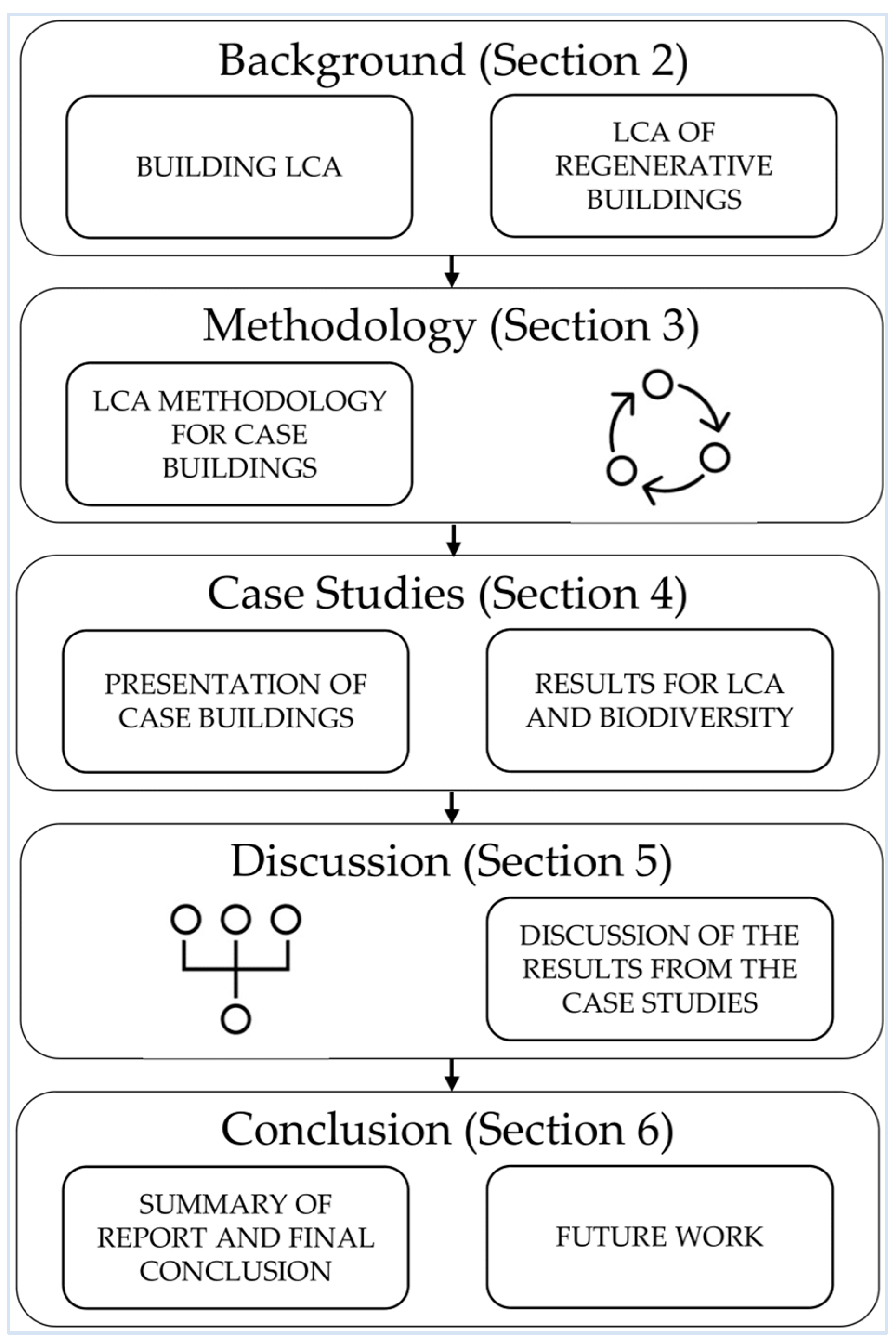
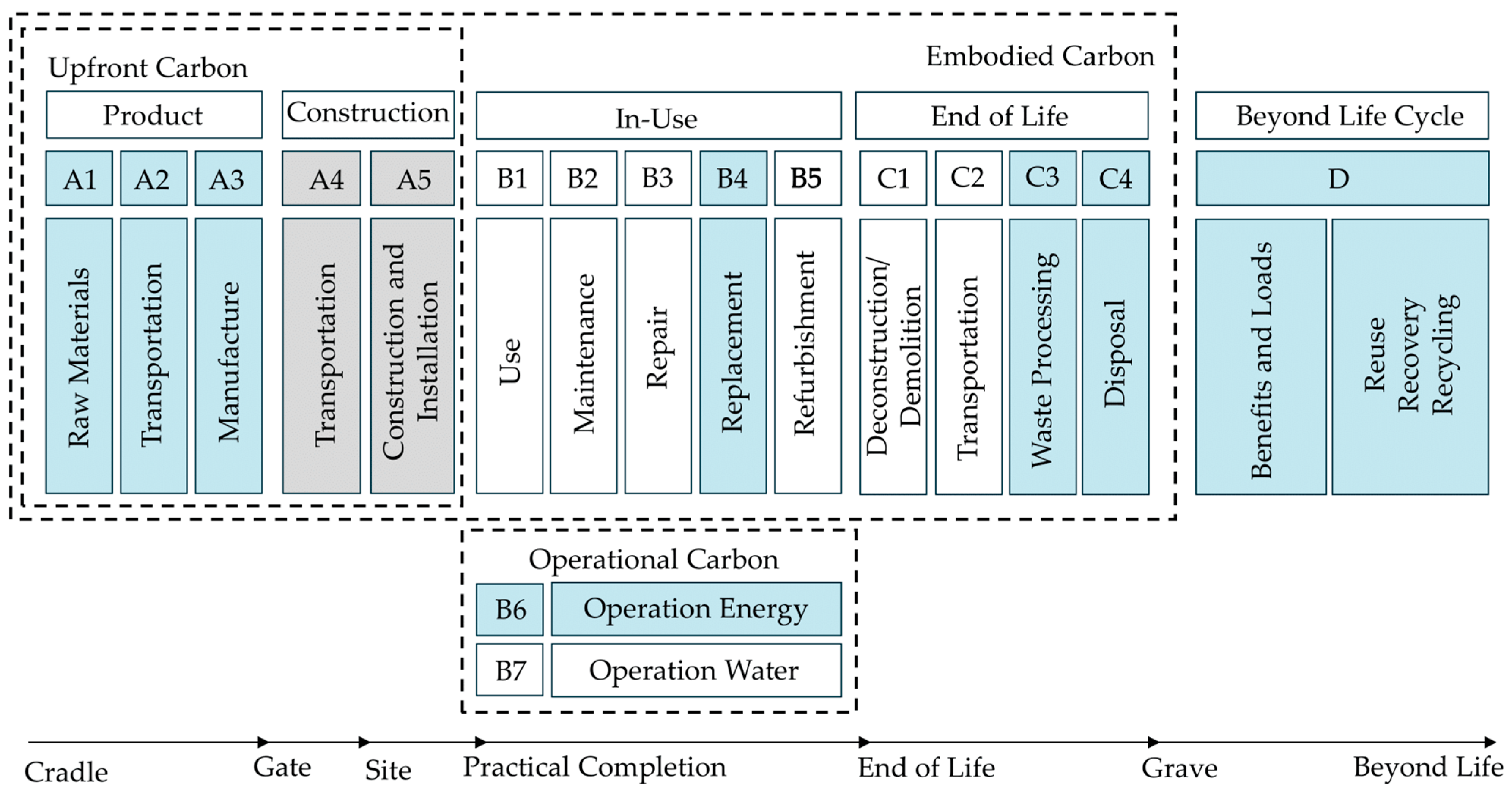
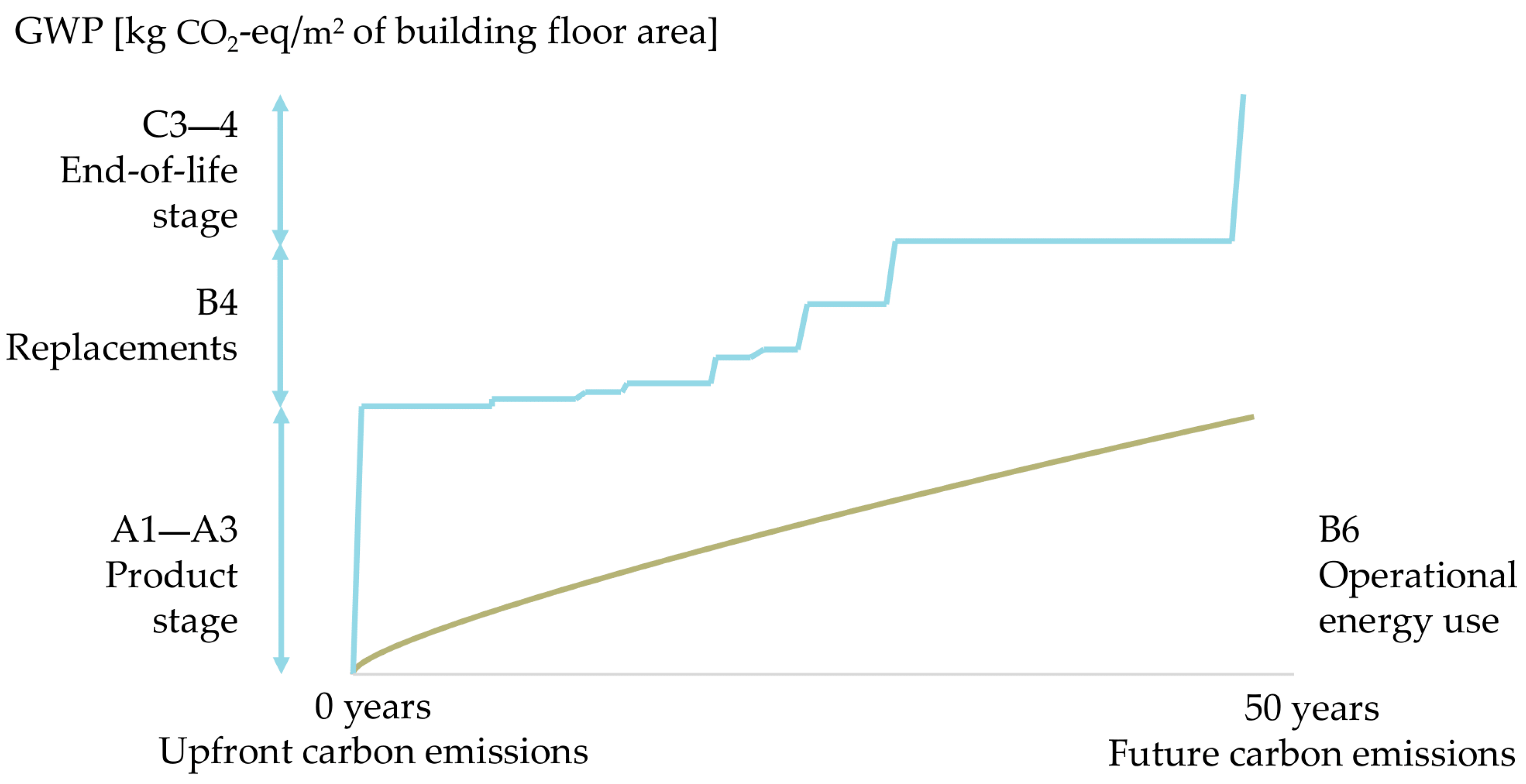


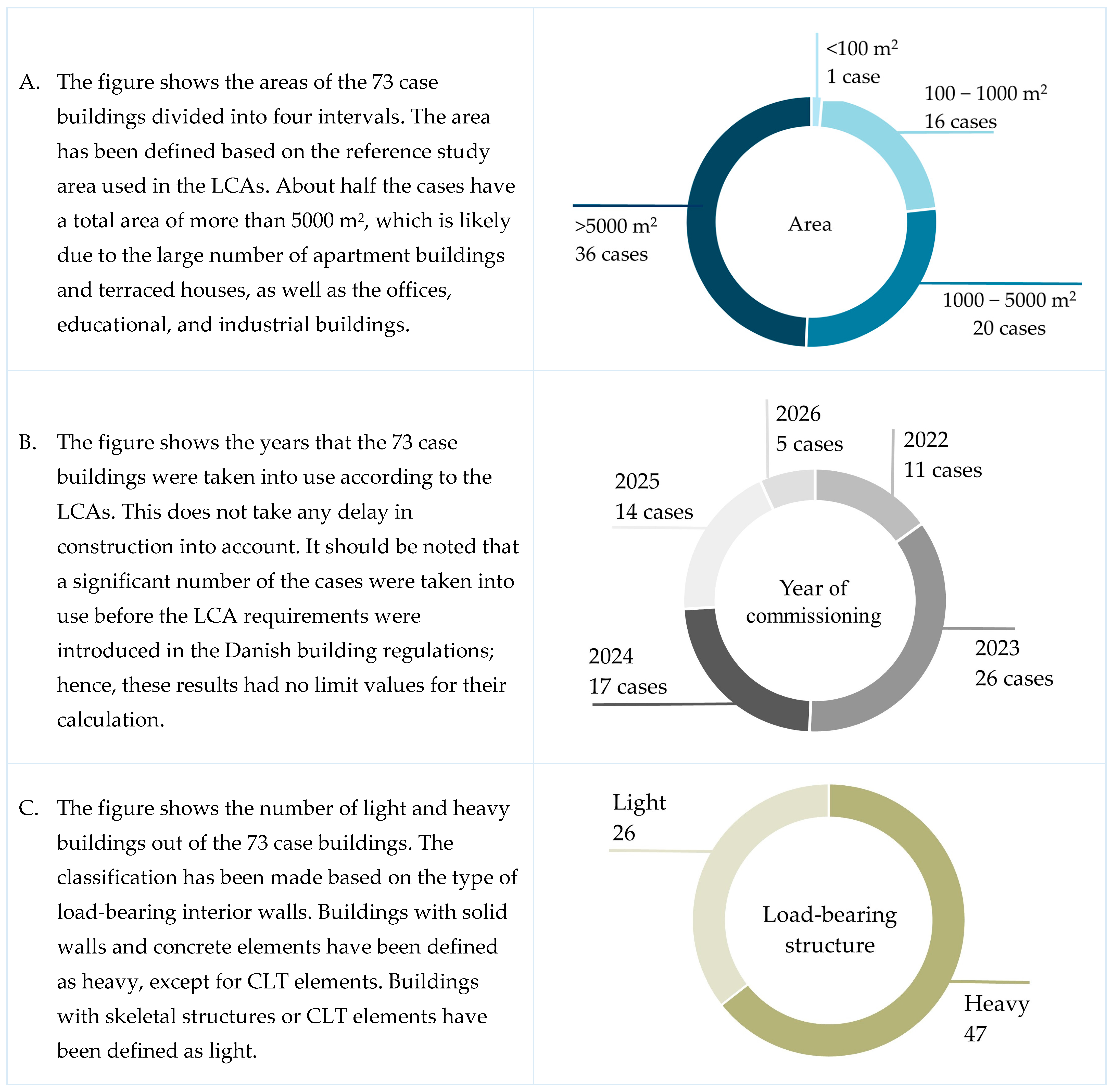


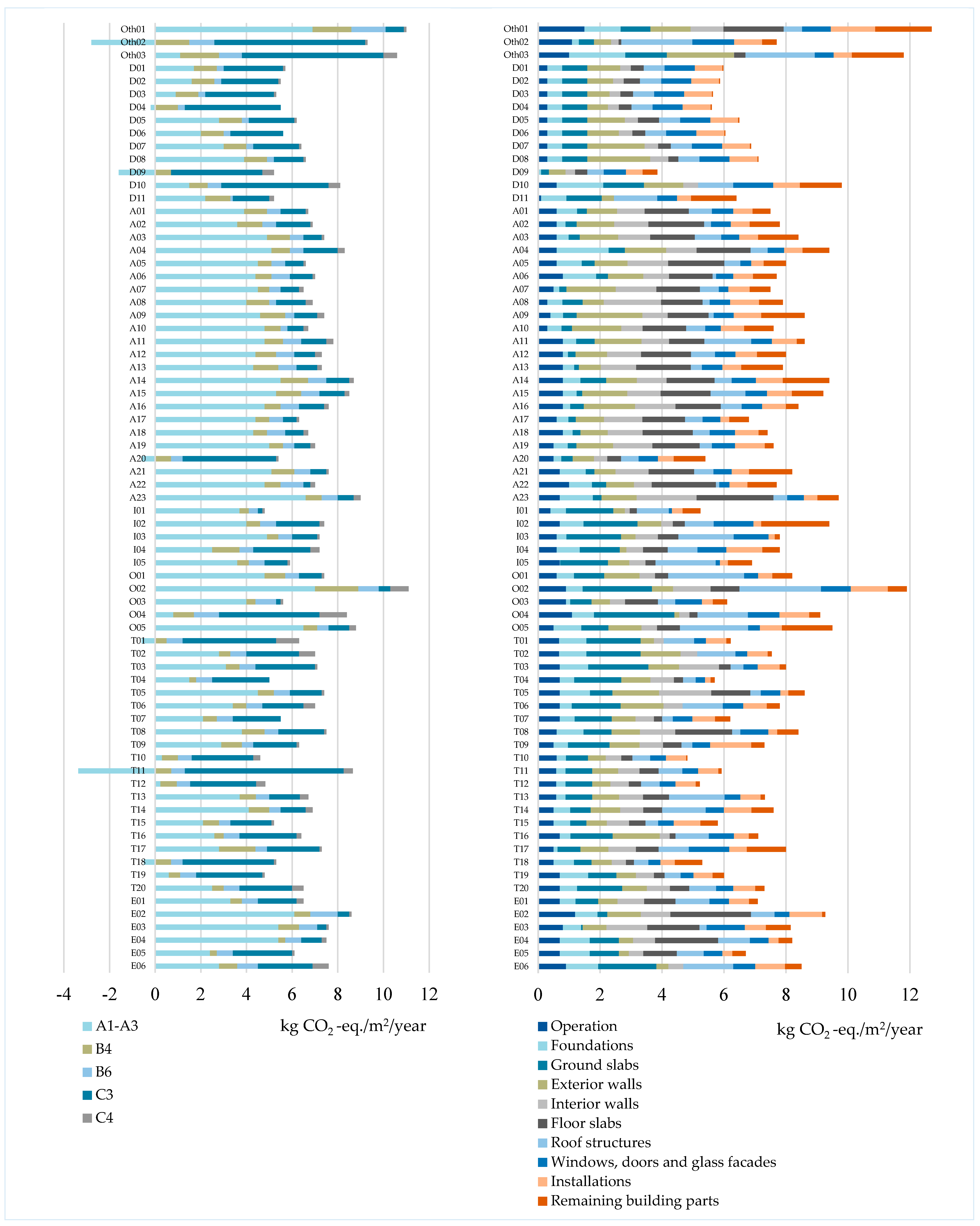

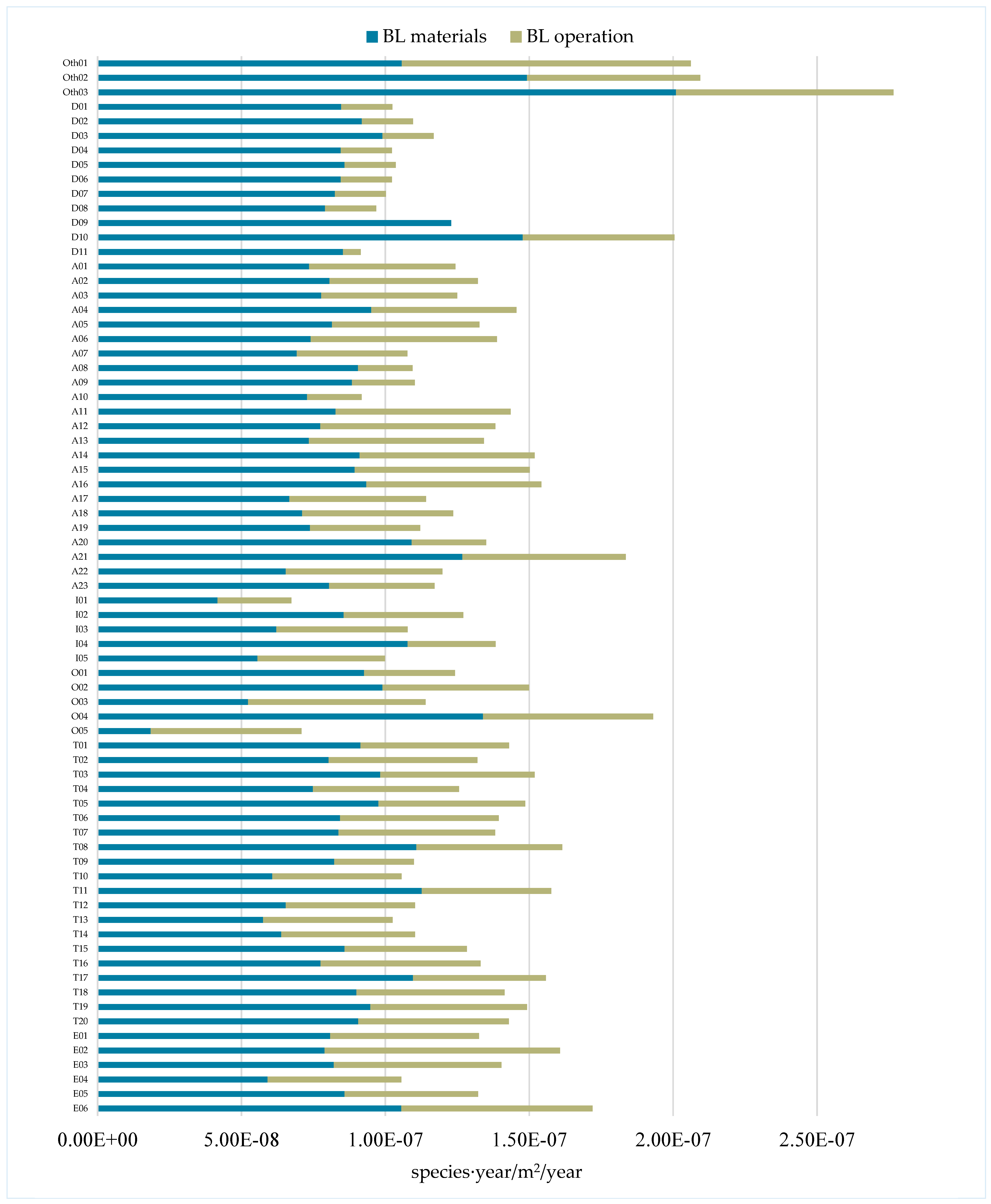
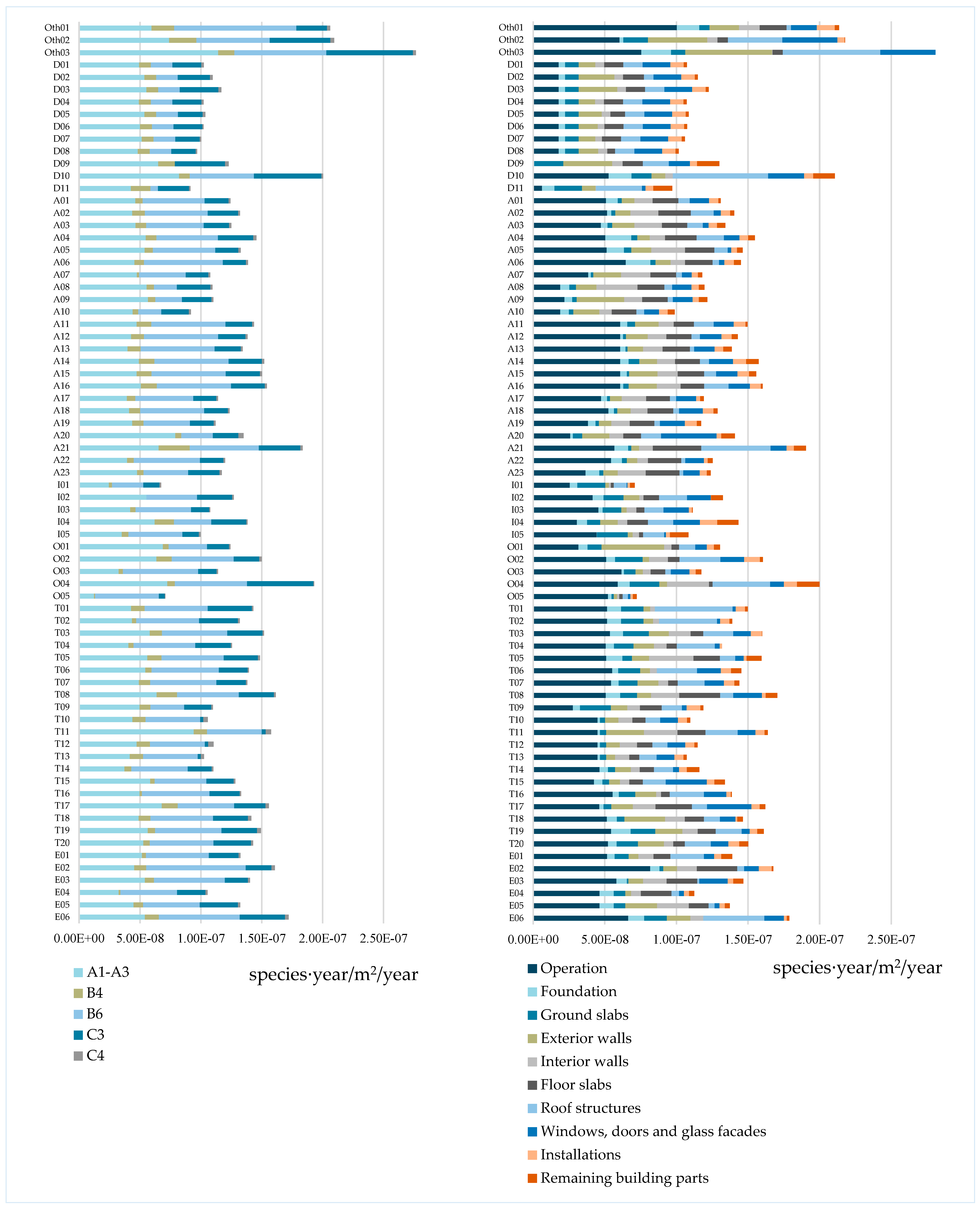
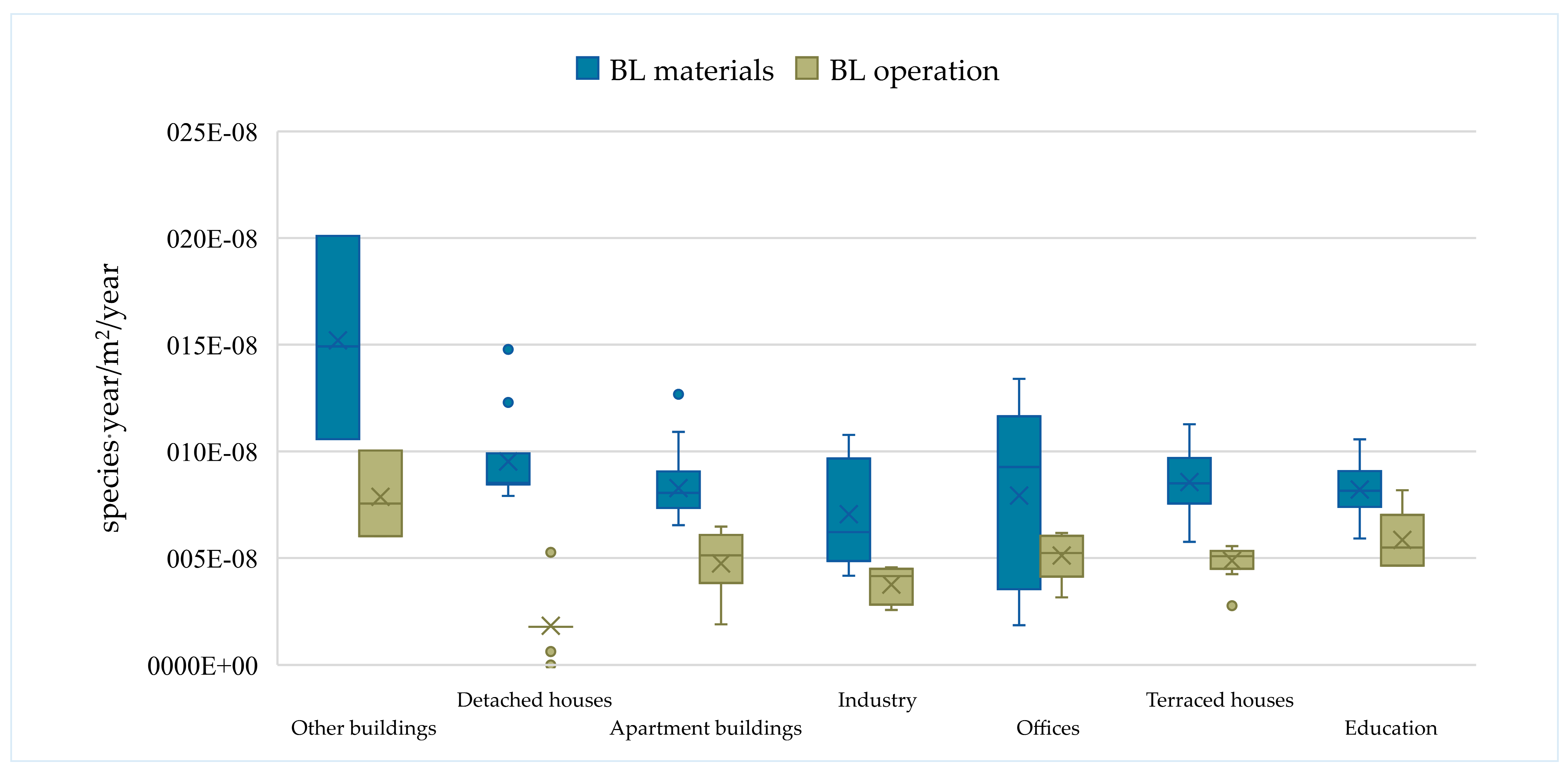
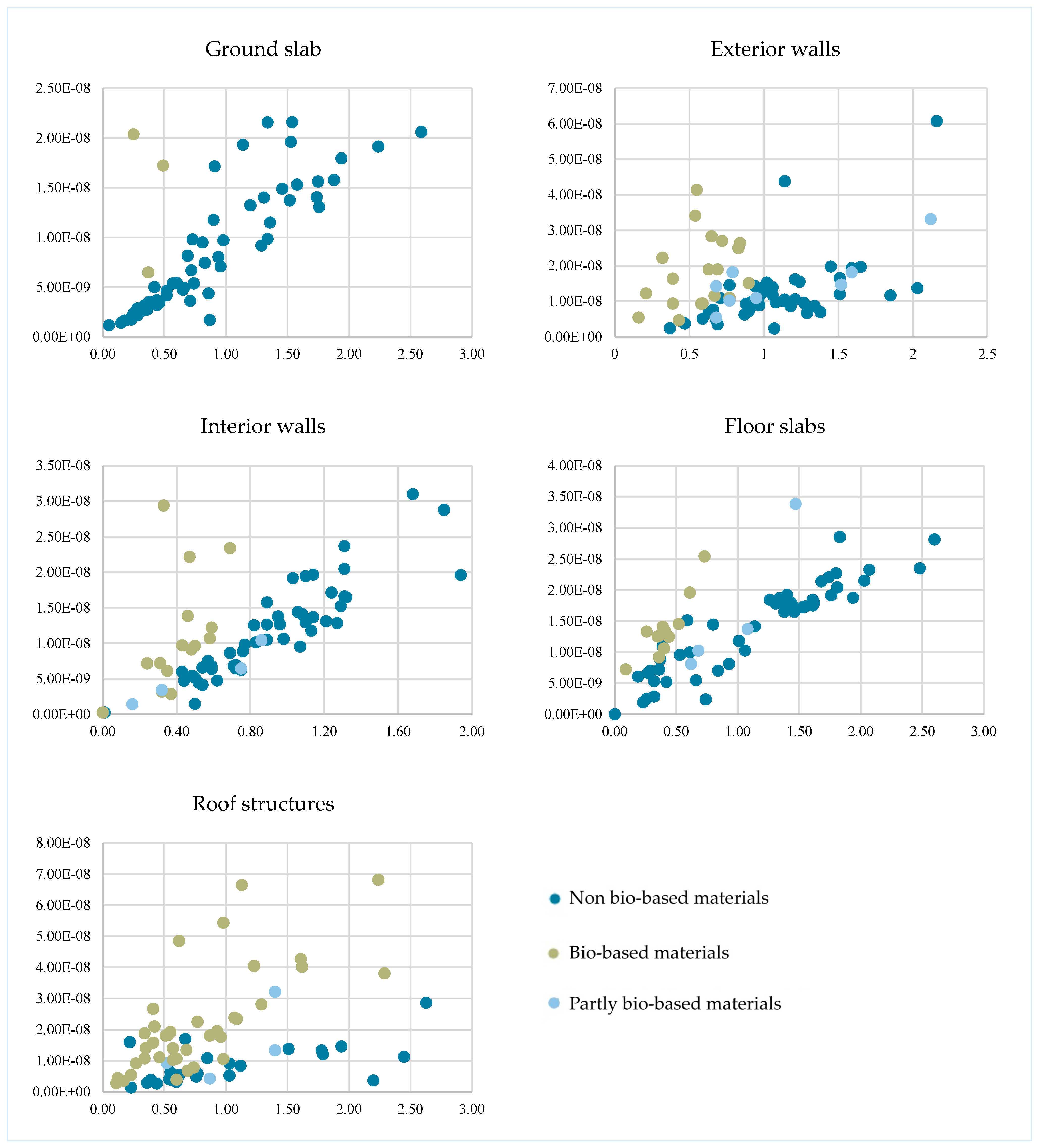
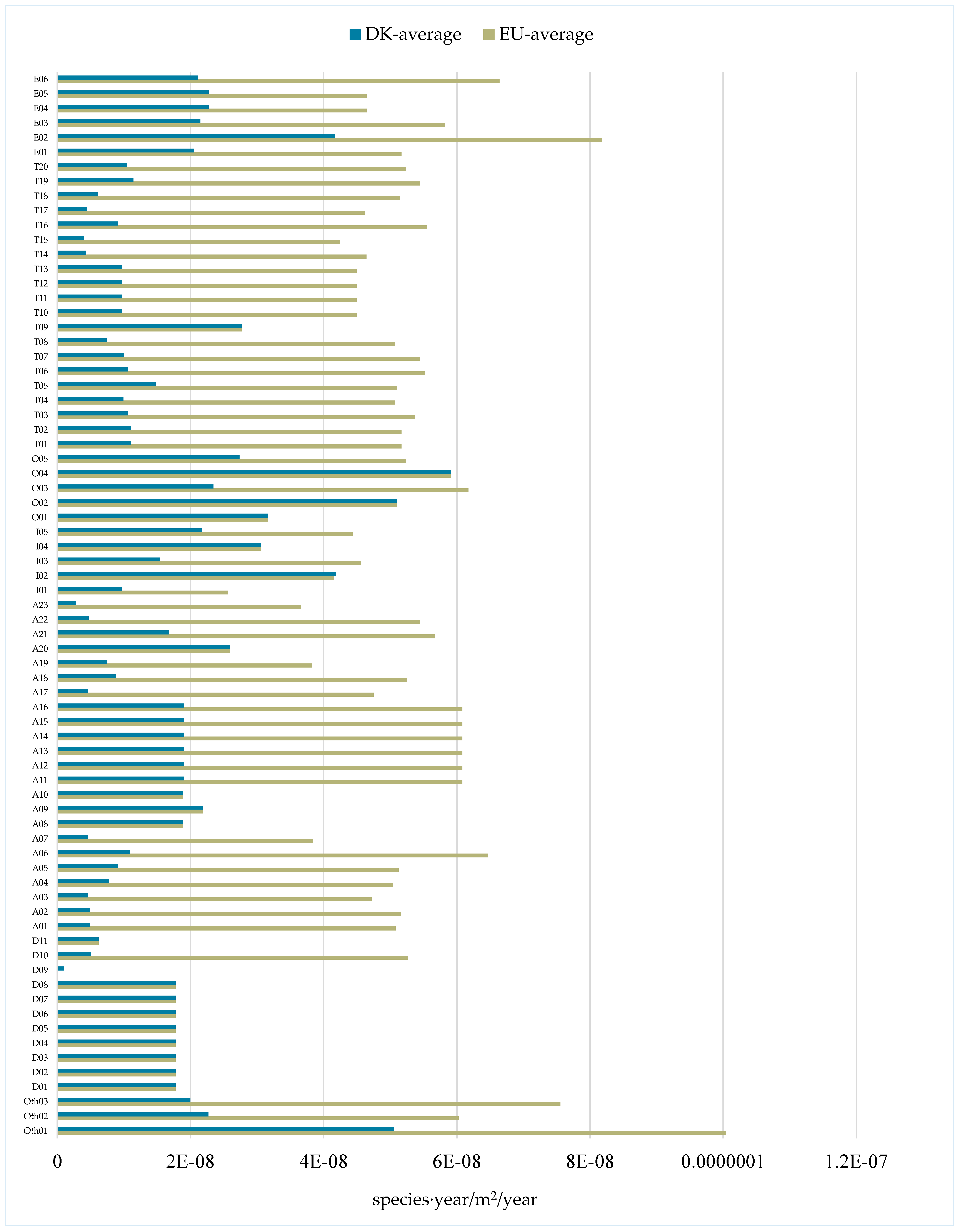
| Climate Requirements | 2025 | 2027 | 2029 |
|---|---|---|---|
| Holiday homes below 150 m2 | 4.0 | 3.6 | 3.2 |
| Detached houses, terraced houses, tiny houses and holiday homes above 150 m2 | 6.7 | 6.0 | 5.4 |
| Apartment buildings | 7.5 | 6.8 | 6.1 |
| Office buildings | 7.5 | 6.8 | 6.1 |
| Institutions | 8.0 | 7.2 | 6.4 |
| Other new buildings, for example, stores, warehouses, and parking garages | 8.0 | 7.2 | 6.4 |
| Impact Category | CML | TRACI | PEF |
|---|---|---|---|
| 1. Global Warming Potential (GWP) | ✓ | ✓ | ✓ |
| GWP—Fossil | ✓ | ✓ | ✓ |
| GWP—Biogenic | ✕ | ✕ | ✓ |
| GWP—LULUC | ✕ | ✕ | ✓ |
| GWP—Total | ✓ | ✓ | ✓ |
| 2. Ozone Depletion Potential (ODP) | ✓ | ✓ | ✓ |
| 3. Photochemical Ozone Creation Potential (POCP) | ✓ | ✓ | ✓ |
| 4. Acidification Potential (AP) | ✓ | ✓ | ✓ |
| 5. Eutrophication Potential (EP) | ✓ | ✓ | ✓ |
| EP—Terrestrial | ✕ | ✕ | ✓ |
| EP—Freshwater | ✕ | ✕ | ✓ |
| EP—Marine | ✕ | ✕ | ✓ |
| 6. Ecotoxicity | ✓ | ✓ | ✓ |
| Ecotoxicity—Freshwater | ✓ | ✓ | ✓ |
| 7. Human Toxicity (HT) | ✓ | ✓ | ✓ |
| HT—Cancer Effects | ✕ | ✓ | ✓ |
| HT—Non-Cancer Effects | ✕ | ✓ | ✓ |
| 8. Particular Matter | ✕ | ✓ | ✓ |
| 9. Ionising Radiation | ✕ | ✓ | ✓ |
| 10. Land Use | ✕ | ✕ | ✓ |
| 11. Resource Use—Fossil Fuels | ✓ | ✓ | ✓ |
| 12. Resource Use—Minerals and Metals | ✓ | ✕ | ✓ |
| 13. Water Use and Water Scarcity | ✓ | ✓ | ✓ |
| 14. Freshwater Ecotoxicity—Long-term | ✓ | ✓ | ✓ |
| 15. Ozone Formation—Human Health Effects | ✕ | ✓ | ✓ |
| 16. Land Use Change | ✕ | ✕ | ✓ |
| 17. End-of-Life Emissions | ✕ | ✕ | ✓ |
| 18. Waste Generation | ✕ | ✓ | ✓ |
| 19. End-of-Life Energy Recovery | ✕ | ✕ | ✓ |
| Feature | ReCiPe 2016 | Impact World+ | LC-Impact |
|---|---|---|---|
| Year published | 2016 | 2019 | 2020 |
| Replaced (Year) | Eco-indicator 99 (1999) CML 2000 (2000) ReCiPe 2008 (2008) | EDIP (2004) LUCAS (2007) Impact 2002+ (2002) | - |
| 1. Midpoint Impacts | ✓ | ✓ | ✓ |
| Climate Change | ✓ | ✓ | ✓ |
| Land Use | Basic | Advanced | Advanced |
| Water Use | Basic | Advanced | Advanced |
| Toxicity | Basic | Advanced | Advanced |
| 2. Endpoint impacts | ✓ | ✓ | ✓ |
| Human Health | ✓ | ✓ | ✓ |
| Ecosystem Damage | ✓ | ✓ | ✓ |
| Resource Depletion | ✓ | Not directly | ✓ |
| 3. Regionalisation | Limited | Advanced | Advanced |
| Method | Strengths | Weaknesses |
|---|---|---|
| ReCiPe 2016 |
|
|
| Impact Word+ |
|
|
| LC-impact |
|
|
| Feature | Ecoinvent | GaBi (Sphera) | Ökobaudat | EPD Danmark |
|---|---|---|---|---|
| Origin | Switzerland | Germany | Germany | Denmark |
| Publication Year | 2003 | 1990 * | 2009 | 2014 |
| Scope | Global, multisector | Global, multisector | Construction-focused | Construction-focused (Denmark) |
| Data type | Background LCI and LCIA | Background LCI and LCIA | EPDs and generic data | EPDs |
| Industry focus | Various | Various | Construction | Construction |
| Assess | Paid | Paid | Free | Free |
| EPD compliance | Some datasets are aligned with EPDs | Supports EPD generation | EN 15804, ISO 14025 | EN 15804, ISO 14025 |
| Used for | LCA studies across multiple sectors | LCA studies across multiple sectors | Sustainable construction and building materials | Danish building sector LCAs |
| LCIA methods | CML, ReCiPe, IPCC, EF and more | CML, ReCiPe, IPCC, EF and more | EN 15804 impact categories | EN 15804 impact categories |
| Feature | Ecochain Helix | SimaPro | LCA for Experts | OneClick LCA | OpenLCA |
|---|---|---|---|---|---|
| Developer (Location) | Ecochain (Amsterdam, The Netherlands) | PRé Sustainability (Amersfoort, The Netherlands) | Sphera (Chicago, IL, USA) | OneClick LCA Ltd. (Helsinki, Finland) | GreenDelta (Berlin, Germany) |
| Founding year | 2011 | 1990 | 1990 * | 2001 | 2006 |
| Cloud/desktop | Cloud | Desktop | Desktop | Cloud | Desktop |
| Access | Paid | Paid | Paid | Paid | Free |
| Modules | Description |
|---|---|
| A1–A3 | Emissions related to raw material extraction, transportation to the factory and production of materials. |
| B4 | Emissions related to the replacement of materials. |
| B6 | Emissions related to energy consumption for operation. |
| C3–C4 | Emissions related to waste treatment and disposal of materials. |
| Building Part | Description |
|---|---|
| Operation | Emissions from operational energy. |
| Foundation | Foundation, including plinth. |
| Ground slab | Ground slab, including flooring. |
| Exterior walls | Exterior walls |
| Interior walls | Interior walls. |
| Floor slabs | Floor slabs, including flooring and ceilings. |
| Windows, doors, and glass facades | All windows and glass facades, as well as both interior and exterior doors. |
| Installations | All drainage, water, heating, and ventilation installations, but not electrical installations. |
| Remaining building parts | Everything not otherwise covered above, such as solar panels, columns, and stairs. |
| Typology | Median | Lower Quartile | Upper Quartile | Requirement * |
|---|---|---|---|---|
| Other buildings | 10.6 | 8.6 | 10.8 | 8.0 |
| Detached houses | 5.6 | 5.3 | 6.3 | 6.7 |
| Apartments buildings | 7 | 6.7 | 7.6 | 7.5 |
| Industry | 7.2 | 5.9 | 7.2 | 8.0 |
| Offices | 8.4 | 7.4 | 8.8 | 7.5 |
| Terraced houses | 6.4 | 5.2 | 7 | 6.7 |
| Education | 7.6 | 6.8 | 7.6 | 8.0 |
| Production | Share |
|---|---|
| Waste incineration | 19.6% |
| Biogas | 1.3% |
| Biomass | 55.2% |
| Industrial heat | 3.1% |
| Coal | 2.7% |
| Natural gas | 4.3% |
| Oil | 1.8% |
| Solar panels | 1.8% |
| Heat pumps | 8.1% |
| Heat pumps, excess heat | 2.1% |
Disclaimer/Publisher’s Note: The statements, opinions and data contained in all publications are solely those of the individual author(s) and contributor(s) and not of MDPI and/or the editor(s). MDPI and/or the editor(s) disclaim responsibility for any injury to people or property resulting from any ideas, methods, instructions or products referred to in the content. |
© 2025 by the authors. Licensee MDPI, Basel, Switzerland. This article is an open access article distributed under the terms and conditions of the Creative Commons Attribution (CC BY) license (https://creativecommons.org/licenses/by/4.0/).
Share and Cite
Terkildsen, E.S.; Sørensen, A.; Kamari, A. Quantification of Biodiversity Loss in Building Life Cycle Assessment: Insights Towards Regenerative Design. Sustainability 2025, 17, 8369. https://doi.org/10.3390/su17188369
Terkildsen ES, Sørensen A, Kamari A. Quantification of Biodiversity Loss in Building Life Cycle Assessment: Insights Towards Regenerative Design. Sustainability. 2025; 17(18):8369. https://doi.org/10.3390/su17188369
Chicago/Turabian StyleTerkildsen, Emma Sofie, August Sørensen, and Aliakbar Kamari. 2025. "Quantification of Biodiversity Loss in Building Life Cycle Assessment: Insights Towards Regenerative Design" Sustainability 17, no. 18: 8369. https://doi.org/10.3390/su17188369
APA StyleTerkildsen, E. S., Sørensen, A., & Kamari, A. (2025). Quantification of Biodiversity Loss in Building Life Cycle Assessment: Insights Towards Regenerative Design. Sustainability, 17(18), 8369. https://doi.org/10.3390/su17188369







